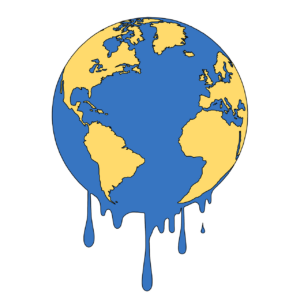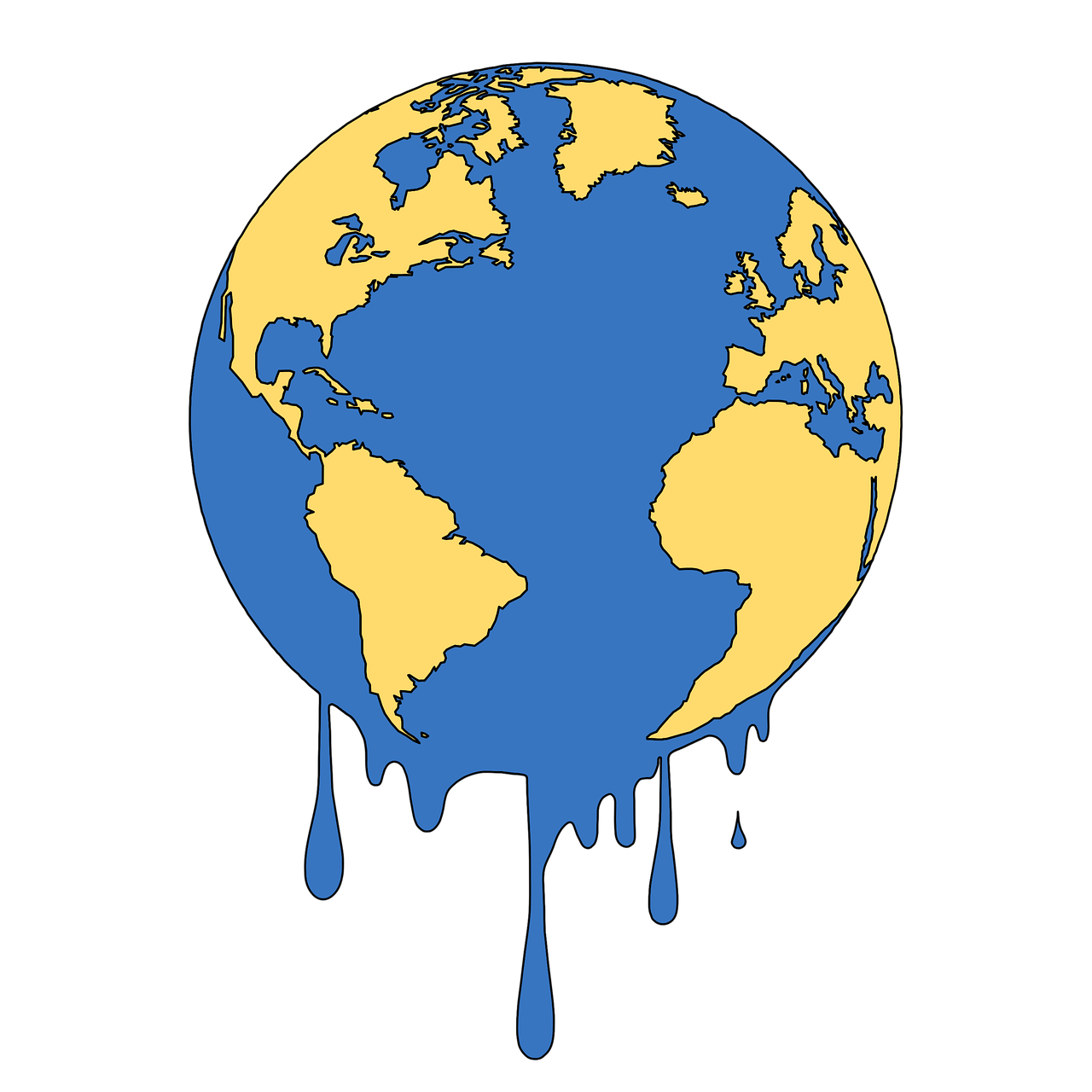The Environmental Crisis: How Social Media is the Turning Point Needed to Drive Change
By: Kaelynn Wallace

Our way of life is deteriorating both our health and the habitability of our planet, yet we remain indifferent.[1] The methods by which our global society produces food, utilizes land and water, travels, consumes energy, and manages a growing population have all contributed to these environmental shifts.[2] Environmental change is alteration of the environment that can be driven by both natural processes and human activities.[3] These changes lead to climate change, pollution, biodiversity loss, and resource depletion.[4] The consequences of these changes can be seen right now.[5] Global temperatures are rising, with the rate of warming accelerating three times as fast as it did in 1982.[6] Nearly the entire global population now lives in areas where the air quality exceeds guidelines, contributing to the premature deaths of 6.7 million people annually.[7] Since 1970, the global wildlife population has declined by an average of 68%, and one million species are currently at risk of extinction.[8] Furthermore, in the past five decades, global resource extraction has tripled.[9]
Despite clear evidence of environmental degradation, our global society continues to worsen the problem rather than confront it.[10] Instead of making necessary changes, we persist in harmful practices, ignoring the urgent need to rethink how we live, produce, consume, and interact with the planet.[11] The reason for this inaction is simple: implementing change would disrupt our current way of life. In other words, too much is at stake—our daily conveniences, such as electricity, cars, grocery stores, and disposable plastics, would no longer be as easily accessible. Several factors contribute to this resistance. These include a focus on short-term priorities, the structure of our economic system, insufficient awareness, political and cultural opposition, and the inherent complexity of change. As a society, we prioritize comfort and convenience, willingly ignoring the long-term negative consequences of our actions. Our reluctance to change comes from an unwillingness to give up these comforts. The familiarity and ease of these practices make it difficult to recognize the need for change, even though the current trajectory is clearly unsustainable.
This lack of urgency will continue until the consequences of our actions begin to affect society, rather than just specific groups or individuals. The fight for change often lacks a clear turning point—an event that shifts the course of history, leaving lasting consequences.[12] Throughout history, we have witnessed pivotal moments, such as the Great Depression, which spurred major changes and reshaped society.[13] These periods led to essential economic reforms, the implementation of new regulations, and significant social transformations—changes that were necessary in response to the damaging effects caused by the absence of such measures in earlier times.[14]
One such pivotal event was the COVID-19 pandemic. This pandemic has effectuated profound changes in our daily lives, impacting both our social interactions and personal experiences.[15] On a societal level, the pandemic’s effects were felt through social media, where new norms and conversations around health, safety, and community emerged.[16] On an individual level, the pandemic reshaped how we connect with others, work, and approach our well-being.[17]
The COVID-19 pandemic was unprecedented, as we faced a virus with no pre-existing immunity, treatment options, or established protocols. It spread rapidly from its origin in China, and the speed of global transmission was amplified by the media, fueling widespread fear, anxiety, and uncertainty.[18] Social media played a crucial role during this time, providing a platform for individuals to share their voices, raise awareness, disseminate information, and foster global collaboration. Platforms like TikTok, where users post 60-90 second videos illustrating how the pandemic impacted lives around the world, became key in reshaping social norms and thoughts.[19] As lockdowns confined people to their homes, social media became the primary means to stay connected with the outside world.[20] This period of societal isolation encouraged reflection on what truly mattered, prompting a shift in focus toward addressing critical issues, such as social inequalities and mental health.[21] With in-person interactions mostly limited to family, people increasingly turned to digital platforms to engage in conversations, seeking connection and a sense of belonging in a time of uncertainty.[22]
A common theme throughout the pandemic was the feeling of missing friends and family, coupled with the fear of losing them to the virus. Between March 2020 and February 2021, the United States alone saw 649,411 excess deaths, with 82.9% of those directly attributed to COVID-19.[23] Despite immense challenges brought by the COVID-19 pandemic—such as widespread illness, loss of life, and disruption to daily life—there were also notable shifts in societal attitudes and improvements in various sectors. Most notably it sparked a renewed focus on how to prevent the spread of illnesses, diseases, and viruses in the future that we did not see before the pandemic.[24]
The pandemic of 2020 highlighted that behaviors once considered normal or even harmless now need to be reevaluated and, in some cases, turned into social taboos.[25] What was once accepted as part of everyday life—like going out in public while sick, using gym equipment without cleaning it afterward, or failing to cover your mouth when coughing or sneezing—has now become culturally unacceptable.[26] The shift stems largely from the fear of the disease, something we’ve always been aware of on some level but never fully confronted. COVID-19 brought that fear to the forefront, amplified by social media platforms, as each of us experienced the impact of the virus firsthand, either through personal illness, the illness of loved ones, or the societal disruptions it caused.[27] As a result, behaviors that could easily spread illness have become stigmatized, and new norms have emerged to prevent the spread of diseases.[28] What was once considered culturally normal now feels socially irresponsible, marking a clear shift in collective consciousness about public health and individual responsibility.
In terms of environmental change, society has yet to encounter a defining moment that alters our collective awareness enough to establish moral taboos around the things we either implicitly or explicitly consume. We remain comfortable with the known fact that everyday activities, like driving cars, contribute to climate change. Although we recognize these facts, there has yet to be a global societal shift that urges us to drastically change our behaviors. Social media, with its power to shape collective consciousness, could be the catalyst needed to drive such a transformation. The climate movement needs a pivotal moment—one that makes the impact of environmental change undeniable and felt by everyone, everywhere. More importantly, there needs to be a shift in the way we perceive the issue, potentially using fear of future devastation, including the threat of widespread death, to accelerate action. Only then will the true urgency of the climate crisis be acknowledged, paving the way for meaningful change.
Link to image source:
https://pixabay.com/illustrations/earth-climate-change-planet-6541426/
[1] Ricky Rood, Will the Earth be habitable in 2100?, Michigan Today (June 25, 2021), https://michigantoday.umich.edu/2021/06/25/will-the-earth-be-habitable-in-2100/.
[2] Id.
[3] European Environment Agency, Environmental Changes and Human Development, https://www.eea.europa.eu/publications/92-826-5409-5/page002new.html.
[4] Id.
[5] World Health Organization, https://www.who.int/news-room/fact-sheets/detail/ambient-(outdoor)-air-quality-and-health (Oct. 24, 2024).
[6] Id.
[7] World Health Organization, https://www.who.int/news-room/fact-sheets/detail/ambient-(outdoor)-air-quality-and-health (Oct. 24, 2024) (“In 2019, 99% of the world’s population was living in places where the WHO air quality guidelines levels were not met.”).
[8] Center for Sustainable Systems, Biodiversity factsheet, University of Michigan (2024), https://css.umich.edu/publications/factsheets/sustainability-indicators/biodiversity-factsheet#:~:text=Globally%2C%20the%20relative%20abundance%20of,average%20of%2069%25%20since%201970.&text=Freshwater%20species%20have%20declined%20the%20most%20globally%20(83%25).&text=As%20of%202022%2C%20211%20plant,2%2C288%20are%20threatened%20or%20endangered.
[9] Id.
[10] Alex Acheampong, Environmental degradation and economic growth: Investigating linkages and potential pathways, 123 Energy Economics (2023).
[11] United Nations, Warning inaction Could Create ‘Dark Future’, Delegates Urge Remaking Global Governance to Benefit All Countries, Not Bolster Powerful Few, as Summit of the Future Conclude, (Sep, 23, 2024), https://press.un.org/en/2024/ga12630.doc.htm.
[12] Dictionary.com, https://www.dictionary.com/browse/turning-point (last visited Mar. 20, 2024).
[13] Great Depression Facts, FDR Library & Museum.
[14] COVID-19 Related Shifts in Social Interaction, Connection, and Cohesion Impact Psychosocial Health: Longitudinal Qualitative Findings from COVID-19 Treatment Trial Engaged Participants, Int J Environ Res Public Health, Aug. 2024.
[15] Id.
[16] Id.
[17] Id.
[18] Liu, M., Zhang, H. & Huang, H. Media exposure to COVID-19 information, risk perception, social and geographical proximity, and self-rated anxiety in China. BMC Public Health 20, 1649 (2020). https://doi.org/10.1186/s12889-020-09761-8.
[19]Julia Jamka, COVID-19 and the TikTok Craze, Inspire the Mind, (Feb 17, 2021), https://www.inspirethemind.org/post/covid-19-and-the-tiktok-craze.
[20] Id.
[21] See generally, CBS News, https://www.cbsnews.com/news/george-floyd-black-lives-matter-impact/, (showing how during the pandemic the killing of George Floyd, “. . .inspired a global reckoning with racism.”).
[22] Maureen Tibbetts et al., A week during COVID-19: Online social interactions are associated with greater connection and more stress, 4 Communications in Human Behavior Report (2021).
[23] Christopher J. Ruhm, Excess deaths in the United States during the first year of COVID-19, 162 Preventive Medicine, (2022).
[24] Dominika Maison et al., The challenges arising from the COVID-19 pandemic and the way people deal with them: A qualitative longitudinal study, PLOS ONE (Oct. 11, 2021).
[25] Fergus G. Neville Et Al., Social norms, social identities and the COVID‐19 pandemic: Theory and recommendations, 15 Social and Personality Psychology Compass (2021).
[26] Linda Laskowski-Jones, COVID-19 and Changing Social Norms, 51 The Journal of Excellence in Nursing Leadership (2020).
[27] Ali Montazeri1 et al., Exposure to the COVID-19 news on social media and consequent psychological distress and potential behavioral change, Scientific Reports (2023).
[28] Giulia Andrighetto et al., Changes in social norms during the early stages of the COVID-19 pandemic across 43 countries, nature communications (2024).
